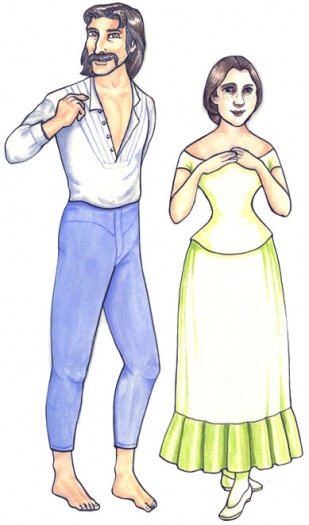
Today's couple is James and Emmaline Hunter. These dolls will probably have the largest variety of heads and clothing styles since they are older characters. James and Emmaline were married in 1844 and James has been for many years (to his dismay) a career soldier, which puts him in a pretty wide variety of uniforms throughout his life (from military academy to wars in the west, to the fall of the Confederacy). He doesn't mind the uniforms, though: he's a clothes-horse and loves fancy things. It also helps that he's fabulously wealthy so he can actually afford these things. Think: Count of Monte Cristo wealthy. Except that he didn't really do anything to earn the money.
Emmaline is almost her husband's diametric opposite. Where he's robust, egotistical and lusty, she's frail, humble, and pious. She comes from a Moravian religious community and would prefer to dress very simply, but the influence of her husband has corrupted her (just a little). She does all of her own sewing (and has the time and money to be extravagant) so she often sews for other people. James also often bribes her to wear fancy clothes now and then ("you put on a silk gown and we'll build an orphanage" ~ that sort of thing). So you can expect to see a pretty wild array of clothing for these two.
Notes on the doll construction: yes, Emmaline is very short. She's a tiny woman. Also, the current heads on these two are post-Civil War. I will be drawing antebellum heads for them as well as heads for when they are old and grey in the 80s-90s.
Lastly, I forgot to caution, for the purpose of downloading and playing with all of the dolls on this blog, I am posting them here with their heads attached. The dolls are actually designed with removable heads ~ not only to change their ages, but to accommodate various hairstyles, etc.
So, if you print the dolls, collars may not lay properly on their neck (and wind up covering their chins). To remedy this (if you are really desperate), print out two copies and cut one set's heads off. Then fasten those heads over the other set so that there is a gap underneath their chins. This was a style I adapted from Raphael Tuck, the difference being that the way mine are constructed, they are actually interchangeable, whereas Tuck's were generally pasted on.
Next time: More introductions or shall we look at something different?
 RSS Feed
RSS Feed
